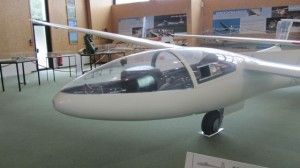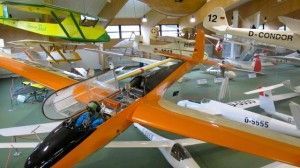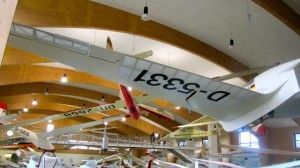In September, my wife Charlotte and I embarked on a three-week vacation in Europe. While Charlotte was planning our vacation, I suggested that we make a couple of side trips to accommodate my interest in soaring: one to visit the famous Wasserkuppe near Poppenhausen, Germany, and a second to tour the DG/LS factory in Bruchsal.
When we arrived in Poppenhausen, the sky was overcast, it was chilly, and a light rain had begun to fall. Not to worry, though. The Wasserkuppe is only ~7km up the mountain from our hotel. We took a bus from town and were surprised when we arrived to find such a large complex of buildings. My mental image of the Wasserkuppe was formed from stories I had read of gliding flights in the 1920s and 1930s, when the site was not so well developed.
There is a hotel atop the Wasserkuppe and two nice restaurants, in addition to dormitories, paragliding and soaring schools, a hard surface runway, the sailplane museum, workshops for repairing gliders, and numerous other hangars and miscellaneous buildings.
We met the chief instructor at the Segelfliegen-Schule (Soaring Flight School), who gave us a private tour of places many visitors never see. The first stop was the large hangar where the Segefliegen-Schule keeps its gliders. Five gliding clubs operate from the site, and many of their gliders and tow planes are kept in the same hangar. There must be at least 12-15 aircraft inside, including two Duo Disci, one with a sustainer and one self-launchable version. Several high performance single seaters and motor gliders round out the fleet.
Our next stop was a large workshop housing several vintage gliders that had been restored to (better than?) new condition by the resident Old-Timers club. The workmanship was absolutely superb! I’ve attached a couple of photos, showing a Rhonbuzzard and one other restoration.
Finally, our guide led us to a hangar with a padlocked door. When he opened it, we were stunned to see a gorgeous stained glass image of Icarus in a window covering much of the far wall. In the center of the floor was a rectangular slab on which lay the sculptured image of a deceased airman, with his straps still on, facing skyward. At the base of the slab was a quote from Otto Lilienthal, the first pioneer of gliding flight, who was fatally injured in 1896 when his glider stalled from a significant height and his back was broken. Before he died, Lilienthal is reported to have said, “Opfer, mussen gebracht werden,” or “Sacrifices must be made.” The sculpture and and the window are a memorial to all the fallen airman who have followed Lilienthal in pioneering and furthering the sport of gliding. The room is ringed with wreaths contributed by soaring organizations and individuals around the world.
As we left the Lilienthal memorial, our guide had to leave us, and we headed for the Gliding Museum. Now I haven’t yet visited the U.S. Soaring Museum in Elmira, NY, but it would be hard to match the Wasserkuppe museum as a repository of gliding history. The museum entrance leads into a large cylindrical room, which houses the oldest gliders. The inner wall is ringed with information and photos about the pioneers of soaring flight. I spent over an hour in this room alone before moving to the newer wing, which is even larger and contains more recent (1950s to 1980s) gliders (and an impressive exhibit of model sailplanes). The first ASW-12, based on the Darmstadt D-36, designed in part by Gerhard Waibel and Wolf Lemke in their student days, is on display, as is the 1957 Phonix, the first glider built from fiberglass. The Horten Wing, a flying wing design developed in the mid-fifties, hangs from the ceiling..
Although we allotted over two hours to the museum visit, I ran out of time before visiting every exhibit. I captured some of the displays on video and took a lot of photos..
If you’re a soaring enthusiast and you find yourself in Germany, I heartily recommend a visit to the Wasserkuppe. You won’t be disappointed!
Although the Schleicher factory is on the edge of Poppenhausen, we didn’t have time to visit both the Wasserkuppe and the factory during our one-day stay. Oh well, it’s a good reason to come back! I did take a few pics of the factory from the bus on our way out of town.
Next stop: Bruchsal and the DG/LS factory!










5 comments for “Visit to the Wasserkuppe”